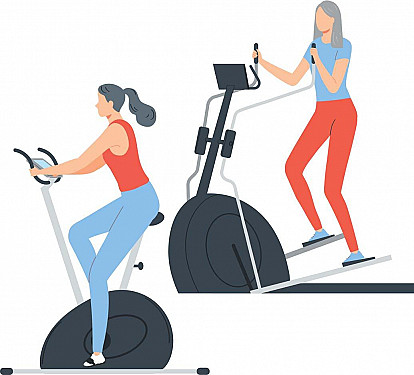Is your walking up to speed?
To maximize your efforts, you need to pick up the pace.
- Reviewed by Howard E. LeWine, MD, Chief Medical Editor, Harvard Health Publishing; Editorial Advisory Board Member, Harvard Health Publishing

Walking is one of the best ways for older adults to get their recommended 150 minutes of moderate-intensity aerobic exercise per week. It requires only a good pair of shoes and can accommodate almost any fitness level. But to ensure you get the most benefits from your walking workouts, you must put in the necessary effort.
"It's easy for fitness walking to turn into casual strolls," says Antonina Stevens, a physical therapist with Harvard-affiliated Spaulding Rehabilitation Hospital. "In order to maintain the minimum level of effort, you must constantly challenge yourself, which means focusing on intensity."
Insight into intensity
One way to measure your walking intensity is to use a target heart rate range. It works like this. First, estimate your maximum heart rate by subtracting your age in years from 220. A typical target heart rate for moderate-intensity exercise is between 65% and 75% of your estimated maximum heart rate. For example, a 60-year-old man would have an estimated maximum heart rate of 160 (220 minus 60). His target heart rate for moderate-intensity exercise would be between 104 and 120 heartbeats per minute.
"When you're walking, you want your heart rate to stay within this range during most of the workout," says Stevens.
You can track your target heart rate with a smart watch, such as an Apple Watch or Fitbit, which measures heart rate from your pulse at the wrist. Or just check your pulse for 15 seconds and multiply by 4. Another option is to use the perceived exertion scale to rate your exertion from 1 to 10, with 1 being complete rest and 10 meaning you're working so hard that breathing is difficult. Moderate-intensity activity is 5 or 6. (See "Walk and talk.") Perceived exertion is often a better measurement for people taking a beta blocker, which blunts the normal exercise-induced rise in heart rate.
Walk and talkThe perceived exertion scale helps you gauge your exercise intensity. For moderate-intensity workouts, aim for 5 to 6 on the scale. |
||
|
SCALE |
INTENSITY |
BREATHING/SPEAKING PATTERN |
|
1 |
Extremely easy |
Restful breathing; able to sing |
|
2 |
Very easy |
Can speak in complete sentences |
|
3 |
Easy |
|
|
4 |
Easy to moderate |
Speech becomes broken |
|
5 |
Moderate |
Breathing becomes heavier |
|
6 |
Talking is difficult |
|
|
7 |
Moderate to vigorous |
Deep, forceful breathing, but still sustainable |
|
8 |
Vigorous |
Labored breathing; cannot talk |
|
9 |
Borderline breathless |
|
|
10 |
Very vigorous |
Gasping for air |
The need for speed
There are many ways to increase and maintain intensity. The obvious one is to walk faster. But that doesn't mean taking longer strides, which actually can slow you down. Instead, focus on improving your walking form using the following strategies. Begin with the first one, "Stand tall." After about a week, add the next tip, continue for another week, and so on.
Pay attention at the beginning of your walks to ensure you follow each tip, and then periodically check to see if you need to correct anything. Some changes may happen quickly, while others may take time to become a habit.
Stand tall. Extend your spine as if you're being lifted from the crown of your head. Keep your shoulders back and down, not scrunched up toward your ears. Your stride is more powerful when your posture is aligned and your core muscles are activated. Standing tall will also help alleviate aches and pains in your upper and lower back and allow you to take deeper breaths for more energy.
Bend your arms. You wouldn't run with your arms straight — it would slow you down. The same goes for walking. When you bend your arms, it's easier to swing them. And since your body likes to be in sync, your legs will speed up to stay in step with your arms. Bend your elbows 85° to 90° and swing your arms forward and back — not side to side or diagonally across your body.
Land on your heel. A heel-to-toe walking motion makes it easier to walk faster than if your foot lands flat with each step. As your leg swings forward, your heel should be the first part of your foot that contacts the ground. Focus on keeping your toes up as you land. Roll through your foot from your heel to your toes as smoothly as possible. Finally, push off with your toes.
Push off strong. Focus on really pushing off the ground to propel yourself forward. For maximum power, bend at the ball of your foot, raising your heel as if trying to show the person behind you the sole of your shoe.
Take shorter, quicker steps. This is the remedy for the common mistake of overstriding (taking longer steps than usual). Instead, focus on shorter, quicker steps — placing your front leg directly under you as you fall into your next step. This allows for a smoother, rolling stride that makes it easier to shift your body weight to your front leg and swing your back leg forward. The result: a faster walking speed.
Keep your front leg straight. Keep your leg straight (but not locked at the knee) from when your foot lands on the ground until it's under your body. This will prevent bouncing. You'll have a smoother stride and propel yourself forward more easily.
Intensity workoutsHere are two workouts that can help you walk at higher intensity.
|
Image: © Jacob Wackerhausen/Getty Images
About the Author

Matthew Solan, Executive Editor, Harvard Men's Health Watch
About the Reviewer

Howard E. LeWine, MD, Chief Medical Editor, Harvard Health Publishing; Editorial Advisory Board Member, Harvard Health Publishing
Disclaimer:
As a service to our readers, Harvard Health Publishing provides access to our library of archived content. Please note the date of last review or update on all articles.
No content on this site, regardless of date, should ever be used as a substitute for direct medical advice from your doctor or other qualified clinician.
















